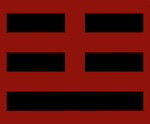This post has been translated from Dutch into English with DeepL. It will be manually edited and streamlined soon.
THE IMAGE of the two trigrams: Earth above, Thunder below. In the depths of the earth, something begins to stir. Germination of seed, the growth of first roots and the irresistible pushing up of plants. The first announcement of spring. Earth over Thunder: the image of returning.
THE IMAGE of the hexagram: one light line under five dark lines. Hexagram 2. Response is formed with six dark lines. All light is gone there. Before the advent of artificial light, every winter there was fear and doubt about the ever-lower sun. When, during the period of the solstice, darkness seemed to definitively dominate, the light returned. The one light line at the bottom of the hexagram penetrates upwards. It outlines the beginning of a new cycle, a return.
The old city of Kampen was known as the town of the sturgeon. Kampen had originated in the IJssel river delta, where the river's fresh water met the salt of the Zuiderzee. Its rich fishing grounds and central location in trade networks had given it prestige and wealth. Sturgeons were present in such numbers that a specialised fishery developed for it.
Sturgeon belonged to the so-called ‘vroonvissen’, just like salmon, sea lamprey, carp and pike. That is, nobility and high clergy were entitled to caught fish as a culinary delicacy. 'City administrators often stipulated that the first sturgeon caught belonged to them. That sturgeon went into the country as a promotional gift. Usually alive,' says Lenders.
Rob Lenders, historisch ecoloog, Radboud Universiteit Nijmegen
Keep reading with a 7-day free trial
Subscribe to Acht is meer dan Duizend to keep reading this post and get 7 days of free access to the full post archives.








